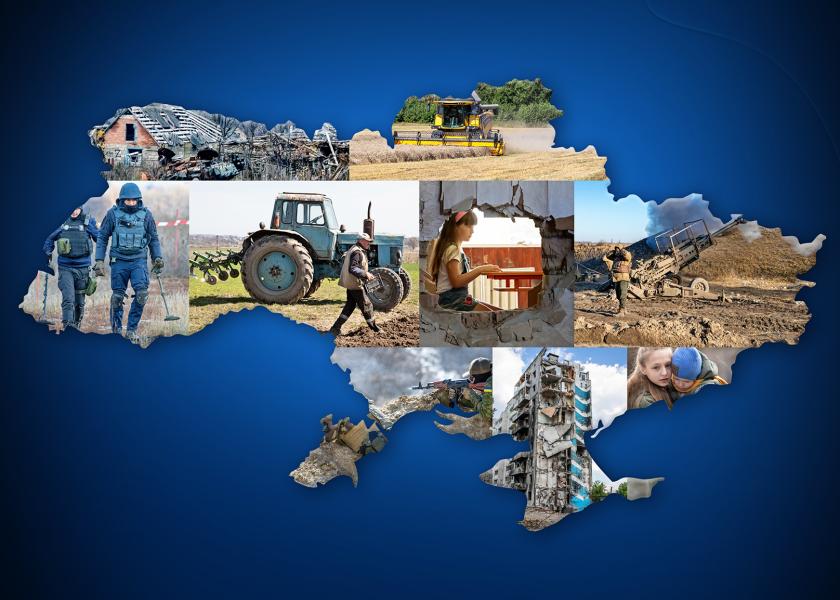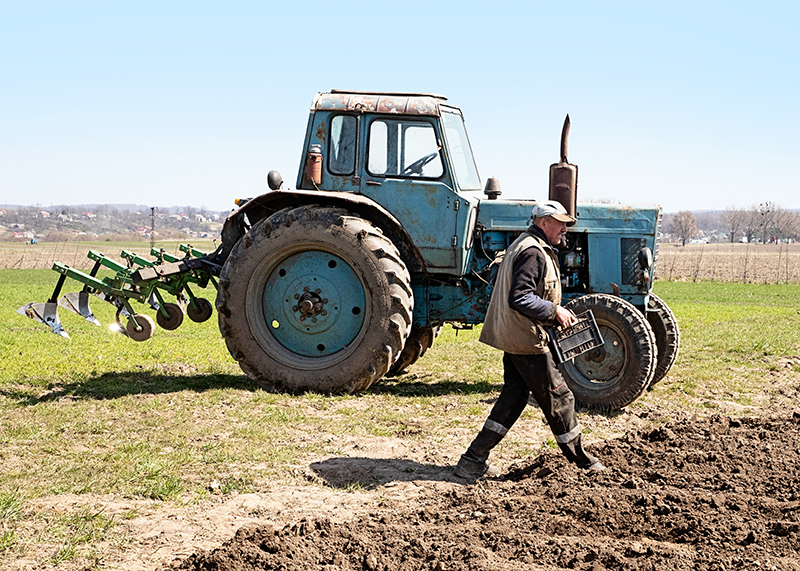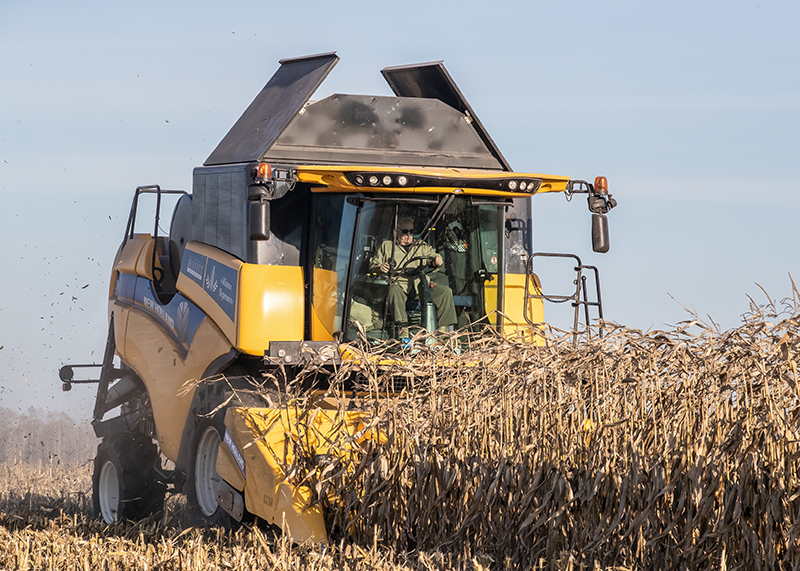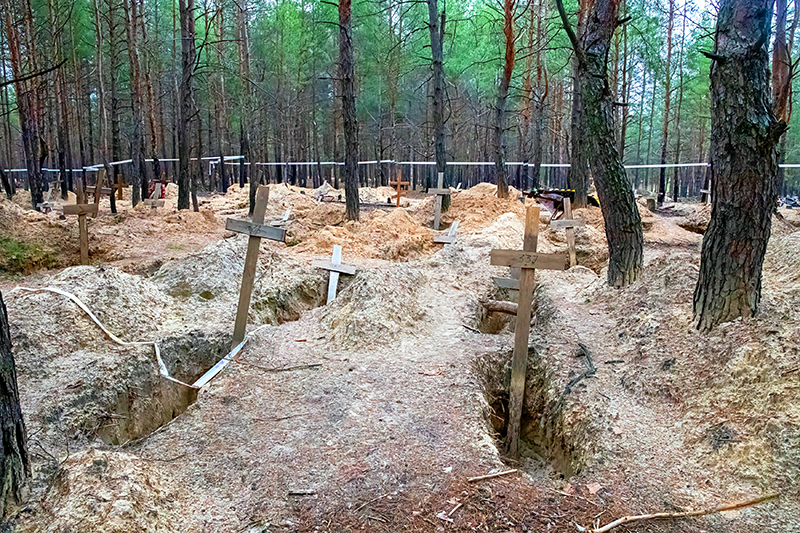Battle For Ukraine: The Untold Farming, People And Infrastructure Stories From The Front Lines

Dressed in protective gear, Illinois farmer Howard G. Buffett bounced his way across frozen back roads, driving in well-worn tracks along the path to Bakhmut, near the front lines of the war in Ukraine. Even in an armored vehicle, the threats of landmines and munitions were ever present.
“In the first 30 minutes or so, as we were driving in, I started to count ambulances that were coming out,” Buffett recalls. “I lost count at 50.”

As a global philanthropist, Buffett is no stranger to war zones and political conflict. His namesake, The Howard G. Buffett (HGB) Foundation, works across the world in places others can’t or won’t to address food insecurity, mitigate conflict, combat human trafficking and improve public safety.
“If people cannot feed themselves, and they cannot feed their family and a government cannot feed people, it breeds conflict,” Buffett explains. “When Ukraine fails, in terms of their ability to produce agricultural products, the world becomes less safe.”
PRODUCTION PROBLEMS
Prior to the invasion, Ukraine was the world’s biggest exporter of sunflower oil and sunflower meal, the fourth-largest exporter of corn and the fifth-largest exporter of wheat, according to USDA. All told, Ukrainian farmers were growing about 100 million metric tons of commodities.
“Ukraine, no matter what happens with the war, will probably see corn and sunflower production 40% to 50% be-low normal,” says Dan Basse, president of AgResource Company.
Ukraine is also a major wheat producer and global exporter. USDA estimates for 2022/23 wheat production will be down about 40% from a year ago. In the eastern areas where most of the conflict is happening, output will be even lower.
Nick Gordiichuk, a farmer near Kyiv, says winter wheat acres will decrease.
“We’re not sure about the functioning of [the grain export] corridor, and weather conditions weren’t good,” he says. “Many farmers are looking at crops that are easy to plant and do not require much fertilizer.”

WAR ON AGRICULTURE
In the past year, Ukrainian farmers have learned it’s increasingly more difficult to grow, harvest and ship products abroad. From limited and high-priced inputs to a lack of labor, production problems appear to be a reality for the foreseeable future.
“A lot of farmers are fighting on the front line and die on the front line, which has a huge impact on how you continue to function in your agricultural sector,” Buffett explains. “This isn’t just a war on civilians, this is a war on agriculture.”
In 2022, the World Food Program (WFP) calculated nearly 350 million people across 80 countries were acutely food insecure. The war in Ukraine is a significant contributor to the surge in hunger and conflict.
“There’s more conflict in Africa today because there are more hungry people; the war in Ukraine has been a big contributing factor,” says Buffett, who has spent considerable time and resources in Africa.
Traditionally, Ukraine has been a major supplier of grain for WFP and many smaller, less stable countries across Africa and the Middle East. That ability has been severely impacted since the outbreak of war.
For U.S. farmers, it is hard to fathom what has happened to their counterparts in Ukraine, Buffett says.
“There are landmines on hundreds of thousands of acres,” he says. “More than $4 billion worth of commodities have been stolen; there’s infrastructure damaged and 84,000 pieces of farm equipment has been destroyed, and it’s not stopping.”
During USDA’s recent Agricultural Outlook Forum, Mykola Solskyi, Ukraine’s minister of agrarian policy and food said the country’s cultivated areas have decreased by about 25%.
“Farmers sacrifice their lives doing their job,” he says. “There are areas farmers cannot cultivate as a result of the war. A considerable amount of land is polluted with explosives.”
COMBINES IN COMBAT
Nearly every day, Buffett receives a photo of farm equipment destroyed by mortars or landmines.
“They just sent me one of a Komatsu D61 bulldozer that hit a landmine,” he says. “It blew the entire track off and blew out half the undercarriage. Thankfully the farmer was okay.”
That isn’t always the case, which is why his foundation is helping to provide detection hardware and expertise to begin the slow process of demining.
“We spent about $30 million on demining in 2022, and it’s going to go on for years,” Buffett says.
As equipment gets destroyed or stolen, sustaining agricultural production becomes nearly impossible without outside support.
“We were able to get 50 combines into Ukraine in about 30 days,” Buffett says. “The fun part of the story is that al-most all of them were originally destined for Russia.”

Roughly 8 million Ukrainians are now living as refugees in Europe and another 6 million are displaced within their own country, per WFP. At last count, 18 million Ukrainians need humanitarian help with one in three facing food insecurity.
In 2022, the HGB Foundation spent $148 million buying equipment, helping feed people, financing food boxes and providing seeds for gardens.
NEVER AGAIN
Buffett’s foundation is also providing rapid DNA testing equipment and investigative teams to do the hard work of cataloging and recording the lives lost. From bodies buried in rubble to the discovery of mass grave sites like the one found near Kharkiv, the job is endless.

“It’s a solemn experience to walk through a forest with 451 hand-dug graves,” Buffett says. “At one site the team said 70% to 80% of the bodies showed some kinds of torture, many with broken fingers or broken limbs.”
After hearing stories of elderly parents shot by snipers, Buffett knows the consequences and horrors of this war will eventually be uncovered.
“We are not learning from history,” he says. “The Holocaust was never again, and Rwanda was never again yet we are watching never again unfold in front of us.”
2023 AND BEYOND
As the conflict stretches into its second year, Ukrainian farmers are caught in the crossfire. For those who can plant, finding a buyer or processor is still a massive challenge.
A protected shipping corridor is set for renewal in mid-March but has seen a significant slowdown. Meanwhile, pushing crops east to Europe via rail comes with its own difficulties, including different track widths.
It’s why in 2023, the HGB Foundation plans to front $5 million to build new export hubs.
“They want to try to start moving grain in containers because the rail system can move lots of containers, and you can transfer them easily onto European trains,” Buffett says.
This year, Buffett says his goal is to spend $300 million in support of Ukrainian agriculture. That includes finding ways to provide lower interest rates for loans and moving equipment and inputs to areas in need.

COMPASSION VERSUS COMPETITION
In five trips to Ukraine, Buffett says the experience of seeing the people, the land and the impact of war, has cast the situation in a different light.
“I know some farmers think they’re a competitor,” Buffett says. “That’s natural. If you want to think that way, that means your neighbor is also your competitor. Yet, we don’t treat our neighbor like they’re our competitor; we treat neighbors like neighbors.”
With a global lens, Buffett has witnessed how important Ukraine is to world stability. For him, it outweighs potentially lower prices when he hauls corn to the elevator in Decatur, Ill.
“It really isn’t a head-to-head competition,” he says. “Helping Ukraine is helping the world.”
Farm Journal Editor Clinton Griffiths is a TV newsman turned magazine editor with a passion for good stories. He believes the best life lessons can be found down a dirt road.







